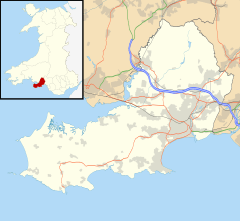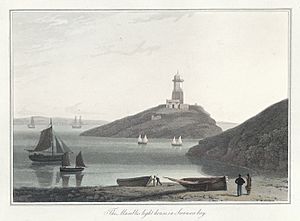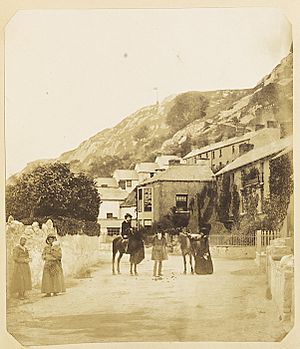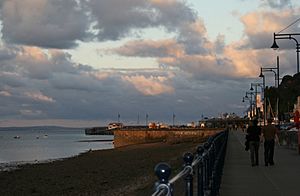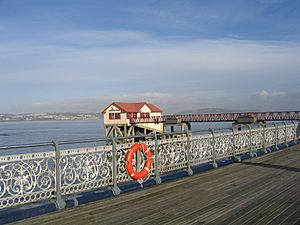Mumbles (district) facts for kids
Quick facts for kids The Mumbles
|
|
|---|---|
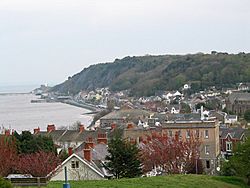 Mumbles viewed from Oystermouth castle |
|
| Population | 16,600 (2011 census) |
| Principal area | |
| Ceremonial county | |
| Country | Wales |
| Sovereign state | United Kingdom |
| Post town | SWANSEA |
| Postcode district | SA3 |
| Dialling code | 01792 |
| Police | South Wales |
| Fire | Mid and West Wales |
| Ambulance | Welsh |
| EU Parliament | Wales |
| UK Parliament |
|
| Welsh Assembly |
|
The Mumbles is a lovely district in Swansea, Wales. It sits right on the south-east edge of the city. Mumbles is also a local area with its own council. In 2011, about 16,600 people lived there. The area gets its name from the Mumbles headland, which is a rocky point at its south-east end.
Contents
Exploring the History of Mumbles
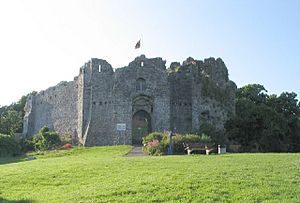
Scientists who study old things, called archaeologists, have found signs of an ancient forest. This forest was once on the shore of Mumbles Bay. Sadly, the sea has since washed it away. Another cave at Mumbles Head was destroyed in 1838. But before that, bones from elephants were found there!
Bones from sixteen different Ice Age animals have been found around Mumbles and Gower. One amazing find is a mammoth tooth. It is ten centimetres wide and you can see it at Swansea Museum.
The first farmers arrived in the Mumbles area over 5,000 years ago. But people lived here much, much earlier! Evidence suggests humans were here as far back as 30,000 years ago. This was found from the famous Paviland skeleton. It was discovered in a cave about 10–15 miles from Mumbles Head. The skeleton is now kept at the Oxford Museum of Natural History.
Swansea Museum also has two well-made flint axe-heads. These tools were found in Newton and on Mumbles Hill. We know a lot about the first metalworkers from the Bronze Age. Their tombs have shown us pieces of pottery, stone piles called cairns, and remains of old huts. There's even an Iron Age hill-fort. Its old ridges can be seen on the cliffs above Redcliffe flats at Caswell Bay.
There are signs that the Romans were in Mumbles too. They had a villa where All Saints Church in Oystermouth stands today. In 1860, workers found a Roman mosaic floor. This happened while they were making the church bigger. This spot was likely a religious place even before the Romans. People say that Roman gentlemen in Wales might have eaten oysters from the beds near Oystermouth.
The Oystermouth Castle was built in the early 1100s. It was one of many castles built in Gower. These castles helped the Normans defend against Welsh Princes. The Princes wanted to get their land back from the Norman invaders.
Important Buildings and Their Stories
Three of the bells in All Saints Church have a special history. They once belonged to a church in Santiago, Chile. They were brought to Mumbles after a big fire in 1863. This fire badly damaged the church in Chile. The Vivian family, who were important in the copper industry, had links to Chile.
In 1793, the Mumbles Lighthouse was built. It stands on the outer of the two islands at Mumbles Head. Then, in 1806, the Oystermouth Railway was built. It ran between Oystermouth and Swansea. It was first meant to carry coal. But people soon saw it could carry passengers too!
On March 25, 1807, a horse-drawn railway started carrying people. This was the first passenger railway service in the world! It became very popular and was known as 'the Mumbles train'. Because of the train, Mumbles became a popular place for visitors.
To make it even better for tourists, the railway was extended. A pier was built and opened in 1898. It became the new end point for the train. A slipway for the RNLI lifeboat was added to the pier in 1916. A boathouse was built there in 1922. These are still used today.
Sadly, on April 23, 1947, the Mumbles lifeboat crew lost eight men. They were trying to rescue the crew of a ship called the Samtampa. The ship had crashed near Sker Point.
The Mumbles railway closed in January 1960. It was taken apart. This was a very unpopular decision. Many people in the area still wish the Mumbles train would come back!
Soon after the Mumbles Pier was built in 1898, it became a place for concerts. There was also a Winter Garden. Both attracted many people. The railway advertised it as 'The Prettiest Pier in the Bristol Channel'. In 1911, the 'Mumbles Press' newspaper wrote about skating rinks and a military band there.
In the 1950s, the end of the Pier had a large entertainment center. It had fun fairground rides like 'Dodgems'. Near the lifeboat bridge, two old amusement kiosks from the early 1900s remained. The land end of the Pier had a cafe and a popular dance hall. In 1966, the amusement area was updated. A new building was added with an arcade, restaurant, and bowling alley. This made it even more popular with visitors.
The Mumbles Mile and Local Culture
The 'Mumbles Mile' is a famous stretch of road in Mumbles. It was once known for having many places to eat and drink. It was a popular spot for people to visit. The famous poet Dylan Thomas was said to have enjoyed spending time at The Mermaid.
The 'Mumbles Mile' became less popular in the 1990s. This was partly because of local council rules. Also, Swansea city centre had more new night attractions. Now, there are only five places on the 'mile'. There used to be more than 20!
The Encyclopedia of Wales says that Mumbles has always felt like a special place. There's even a verse that describes it:
- Mumbles is a funny place,
- A church without a steeple,
- Houses made of old ships wrecked
- And most peculiar people.
The TV mini-series Mine All Mine, starring Griff Rhys Jones, was filmed in Mumbles in 2004.
Villages in the Mumbles Area
The villages that are part of the Mumbles community council area are:
- Blackpill
- Mayals
- Langland
- Limeslade
- Newton
- Norton
- Oystermouth
- Thistleboon
- West Cross
Mumbles' Twin Towns
The Mumbles community has special links with two towns in other countries:
Famous People from Mumbles
Many well-known people have connections to Mumbles:
- Thomas Bowdler, who helped edit Shakespeare's plays, is buried in Oystermouth.
- Bishop Graham Charles Chadwick, who worked against apartheid, served at All Saints Church and is buried in Oystermouth Cemetery.
- Alan Curtis, a former Wales international footballer, lives in Mumbles.
- Ian Hislop, a writer and editor, was born in Mumbles.
- William Hughes, a boxer and child actor, was born in Mumbles.
- Alun Wyn Jones, captain of the Wales national rugby union team, grew up here.
- Jean Jenkins, an Australian senator, grew up in Mumbles.
- Joanna Page, an actress, was born in Treboeth Swansea.
- Richard Valentine Pitchford (also known as Cardini), a Master Magician, was born in Mumbles in 1895.
- Mal Pope, a musician and composer, lives in Mumbles.
- Robert Pugh, an actor, lives in Mumbles.
- Cara Readle, an actress, grew up in Mumbles.
- Andy Secombe, a voice actor, actor, and novelist, was born in Mumbles.
- Hannah Stone, a Royal Harpist, grew up in Mumbles.
- Bonnie Tyler, a singer and songwriter, lives in Mumbles.
- Melanie Walters, an actress, lives in Mumbles.
- Rowan Williams, a former Archbishop of Canterbury, grew up in the area.
- Catherine Zeta-Jones, an actress, grew up in Mumbles from age 12. She and Michael Douglas have a house there.


